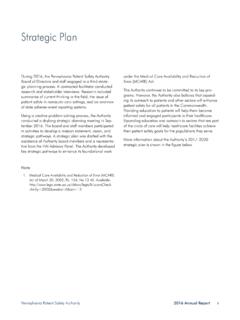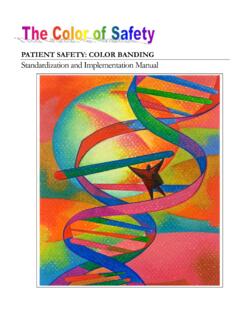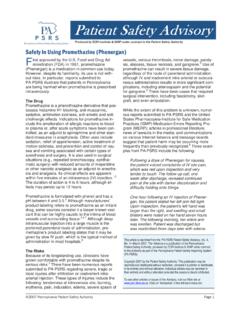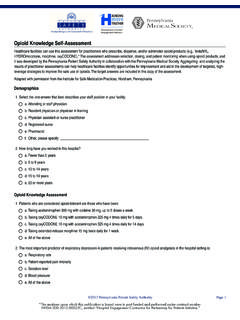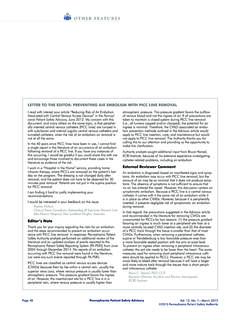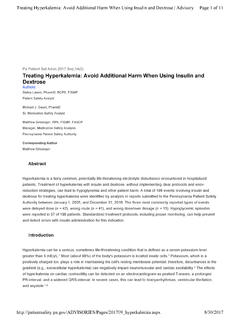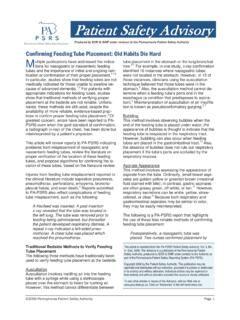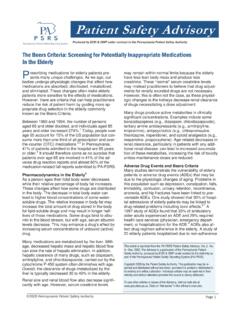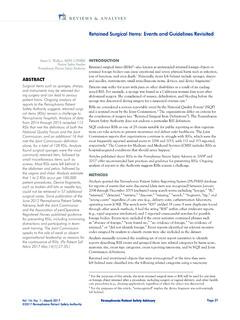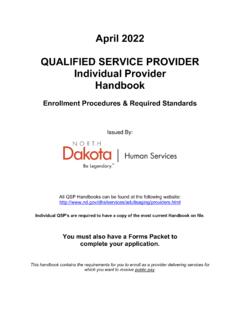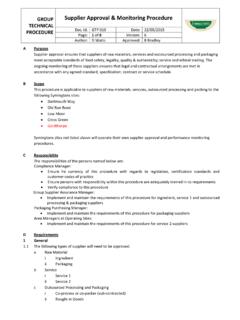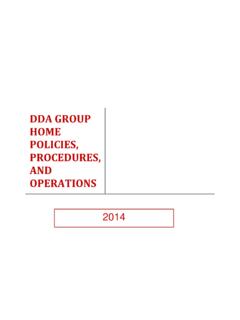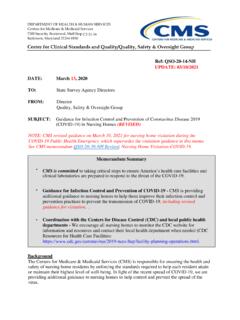Transcription of PATIENT SAFETY AUTHORITY AND DEPARTMENT OF HEALTH
1 NOTICES. PATIENT SAFETY AUTHORITY AND DEPARTMENT . OF HEALTH . Final Guidance for Acute Healthcare Facility Determinations of Reporting Requirements under the Medical Care Availability and Reduction of Error (MCARE) Law [citation]. [date]. Purpose This document outlines final guidance to Pennsylvania acute healthcare facilities in making determinations about whether specific occurrences meet the statutory definitions of Serious Events, Incidents, and Infrastructure Failures as defined in Chapter 3 of the Medical Care Availability and Reduction of Error Act of 2002.
2 This guidance was developed by a multi- disciplinary work group consisting of staff from the PATIENT SAFETY AUTHORITY ( AUTHORITY ), two physician members of the AUTHORITY 's Board of Directors, and the DEPARTMENT of HEALTH (the DEPARTMENT ), as well as representatives of the Hospital and HealthSystem Association of Pennsylvania (HAP), the Hospital Council of Western Pennsylvania (HCWP), and the Pennsylvania Ambulatory Surgery Association (PASA). The work group included individuals with backgrounds in medicine, nursing, administration and facility operations, regulation, and PATIENT SAFETY and healthcare quality.
3 Draft guidance was issued for public comment on January 4, 2014, and this document includes the agencies' response to the 53 letters received. This guidance was developed to provide consistent and clear standards for MCARE's reporting requirements so that the AUTHORITY , the DEPARTMENT , and healthcare facility staff have a shared understanding of the requirements. The subjects of these requirements were identified based on frequently asked questions, controversies, and inconsistencies that are evident in the data collected by the AUTHORITY and the DEPARTMENT .
4 They include many subjects identified in a 2009. draft guidance document the AUTHORITY issued for public comment which was never subsequently issued as final guidance from the AUTHORITY and the DEPARTMENT . 1. Implementation The principles below have been approved by the PATIENT SAFETY AUTHORITY and the DEPARTMENT of HEALTH . The agencies are in the process of modifying PA-PSRS to support implementation of these standards and developing an education program to inform PATIENT SAFETY Officers and other stakeholders of these changes. Education will be made available prior to changes taking effect in PA-PSRS.
5 Current plans are to have the new standards go into effect on April 1, 2015. Statutory Definitions of Reportable Events Serious Event: An event, occurrence or situation involving the clinical care of a PATIENT in a medical facility that results in death or compromises PATIENT SAFETY and results in an unanticipated injury requiring the delivery of additional HEALTH care services to the PATIENT . Incident: An event, occurrence, or situation involving the clinical care of a PATIENT in a medical facility, which could have injured the PATIENT , but did not either cause an unanticipated injury or require the delivery of additional HEALTH care services to the PATIENT Infrastructure Failure: An undesirable or unintended event, occurrence or situation involving the infrastructure of a medical facility or the discontinuation or significant disruption of a service which could seriously compromise PATIENT SAFETY .
6 Final Guidance on Reporting Standards The final guidance on reporting standards appears below. Some of these standards have been revised in response to feedback we received during the public comment period. Descriptions of all comments received and our responses to those comments appear in the subsequent section. Interpretations of Serious Event Definition & Component Terms 1. The concepts of human error and preventability do not appear in the Serious Event definition. It is not necessary for an error to be involved, nor for the harm to be preventable, for a death or unanticipated injury to constitute a Serious Event.
7 2. The unanticipated nature of the injury is from the perspective of a reasonably prudent PATIENT . While every provider anticipates some rate of complications from the procedures they perform, infrequent complications are rarely anticipated by the PATIENT unless the PATIENT is somehow at increased risk. While we do not specify an exact threshold for the frequency of complications that makes a particular complication transition from unanticipated to anticipated, complications that occur rarely would be unanticipated by most reasonably prudent patients. 3. The disclosure of a potential complication on a PATIENT consent form does not, in itself, constitute anticipation of the complication by the PATIENT .
8 Informing the PATIENT of a risk does not mean the PATIENT or the provider anticipates that the untoward outcome will actually occur. 2. 4. Complications may be considered anticipated (and therefore not meeting the Serious Event definition) when they occur frequently, or the risk of the complication is considered high for a particular PATIENT , and the high probability of this complication was disclosed to the PATIENT in the informed consent discussion and documented either on the consent form or medical record. 5. A Serious Event that is within statistical norms or within benchmarks available in the clinical literature must still be reported.
9 There is nothing in the law that allows for reporting Serious Events only when they exceed a statistical norm or benchmark. 6. A Serious Event can include an unanticipated event, occurrence or situation that: a). hastens death (as in a terminally ill PATIENT ); or b) exacerbates a preexisting condition requiring additional HEALTH care services. 7. The event, occurrence, or situation that caused the death or unanticipated injury may be unknown but may still constitute a Serious Event. For example, a healthy (ASA I) PATIENT undergoing elective surgery dies unexpectedly during the procedure and the cause of death is unknown.
10 8. Any unnecessary invasive procedure or invasive procedure performed in error that carries risk for the PATIENT constitutes an injury, and performance of the correct or intended procedure then constitutes additional healthcare services. These occurrences are Serious Events. 9. Additional healthcare services: a. If a PATIENT sustains an unanticipated injury for which no additional healthcare services are possible, but treatment would be provided if options were available, this is considered a Serious Event. b. If a PATIENT sustains an unanticipated injury, and additional healthcare services are possible, but the risk of those services outweigh the negative consequences of the injury, this is considered a Serious Event.

